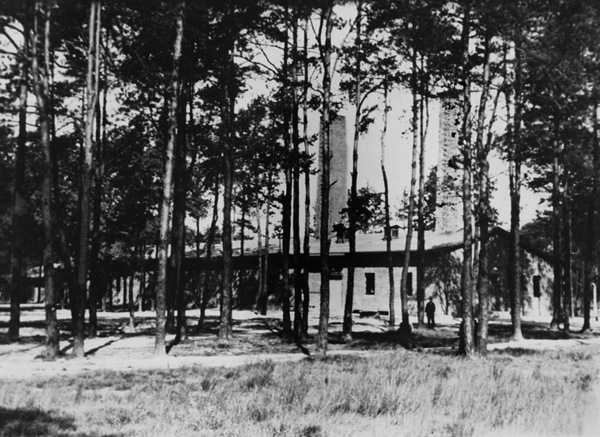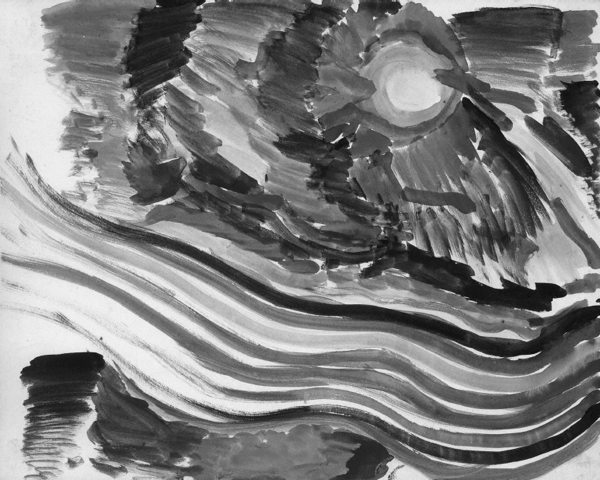
Final Liquidation of the ‘Family Camp’
At the end of six months, in the course of one night, all five thousand, or all who remained of the five thousand who arrived with us in September 1943, were annihilated. On that night in March 1944, nearly all of them died in the gas chambers, apart from a few who only by chance happened to be hospitalized and were left alive in order to deceive the others – the doctors and the patients – my mother and I among them. Those who arrived in later transports knew that, like their predecessors, they had about six months left to live. Why? No one knew. When I returned from the hospital, the whole life of the camp was conducted under the certain knowledge that, like the inexorable sands of an hourglass, the days were running out and would end in the crematoria.
The liquidation began in July, this time differently. Everyone in the camp underwent a ‘regular’ selection, the conventional way at Auschwitz. Those fit for work were sent to labour camps in Germany – my mother was among them – the others to the gas chambers. I was one of those others, designated to die by gas, for the second time. The first time I had come through by chance, but the second time chance did not appear on the horizon until, once more in an unexpected way, the end was postponed. After the selections were concluded, an order arrived to choose several dozen youths for work in the camp, such as hauling carts, because, after all, manpower was cheaper than horses, which were a precious commodity. Accordingly, we were transferred to a different camp and thus eluded this stage of the liquidation of the family camp.
‘The Eternal Death of the Child – the Eternal Death and Resurrection of the Great Death’
These things are bound up with several situations which recur within a kind of mythic dreamscape. That night in March, in which all my childhood friends – and part of my family, as I discovered the following morning – were annihilated, comes back in images which I did not see with my own eyes but which I continually re-experience. How they enter the gas chambers and I with them, because I belong to them. How they and I enter the corridor and afterwards the gas chambers and I with them. And how I at the last minute, by some roundabout way, escape – once through the opening created when a small, rusting iron door opens, another time through some sort of subterranean stream of water – and I come out of the crematorium and dig beneath the barbed wire. Numberless images like this.
On one occasion I deliver a speech to the youths in the block, trying to persuade them that, even though the place to which we are to be taken has been described to us as a labour camp, this is no more than an exercise in deception, and in fact we are condemned to die. When we arrive there I somehow slip away, I do not go with them, I escape alone. I know – as we approach the place – that I will escape – or, actually, not that I will escape but that at the last minute events will not sweep me up. This basic certainty – wholly rational – that the only way out of here is the gas, the suffocation and the fire, is so powerful that it is impossible not to believe in this. And nonetheless I believe.
This is a concrete situation which recurred several times in Auschwitz itself and returns paradigmatically, as dreams, whether of escape or return; escape by train, the image of a deserted night station, when suddenly the loudspeakers call my name and I report and am sent back to Auschwitz, to the crematoria; and I know there is no escaping them and that the only way and the only law that governs them is the fulfilment of an imperative and resignation to death and annihilation. Yet I also know that at the last minute somehow I will not become enmeshed in that immutable law, that here something is different. This is a hope which, though I do not believe in it, is always present and in the end becomes certainty, rife with fear and torments – not torments but terror and feverish flight and feverish extrication in one way or another – and all recurring in numberless variations.

15.
In Auschwitz itself I underwent the experience concretely, a number of times. The second time was when we, a group of youths, left the camp, knowing that the camp administration often misled people and reassured them, in order to avert attempts at rebellion by veteran inmates who knew what the road to the crematoria meant. We were told that we must go through the ‘sauna camp’ – a camp where body and clothing of the arriving inmates were disinfected – and then go on to the main camp. We left our camp; it was the first time we had passed through the gates of the camp. We turned left and drew ever closer to one of the crematoria. We were all unendurably tense. The feeling that this immutability of the law, of liquidation, of annihilation, would devolve on us was stupendous, overpowering. The hope that perhaps, after all, we were not being tricked, was there. It was searing, feverish, but very hesitant, and with every step that brought us closer to the crematorium the horror mounted. The black gates, the fences we could not see over, filled us with dread. The prisoners, who came from every corner of Europe, stood and waited for hours. Few knew what awaited them – but we knew, we knew all about this ‘industry’.

16.
We gazed at the smokestacks of one of the crematoria there. Step by step we drew closer. That primal experience of looming horror and of being sucked into it, swallowed within it – that is what persisted; that, and not the relief, the overwhelming feeling of relief as we walked past the gate and continued toward the ‘sauna camp’ and entered it and through the windows could even see into the crematorium compound – all this I somehow remember, but this experience did not persist in the memory. The primal experience, the one that persisted, is the trauma, recurring numberless times and encapsulating, like a highly concentrated essence, the immutable law of the Great Death. A law that prevailed and applied to each and every one of us. Grappling with it – hopelessly – yet aspiring compulsively to escape its clutches, was a formative experience.
The ‘Small Death’ and the ‘Life beyond Death’
A completely different type of encounter with the Auschwitz form of death lay in a kind of development, if one can put it like that, an involuntary upgrading of the games of daring, the games of touching the electrified barbed-wire fence. This was in October 1944. By then I was already in the men’s camp together with my father, working as an apprentice to a group of blacksmiths, of whom my father was one. Every day after work I would pass a small metal container of soup to my uncle through the barbed wire. The uncle, my mother’s brother, had arrived from Theresienstadt and was in an adjacent camp. That particular day, around dusk, was the same. But on that day a revolt broke out among the Sonderkommando inmates in one of the crematoria, an event which became fateful for me as well. The inmates rebelled, set fire to the crematorium, and tried to escape. The procedure in such cases was to electrify the fence. Of course, I did not learn about all this until afterwards.
As I did every day, I passed the container with the soup through the fence, and at one point I touched the barbed wire. I felt shocks run through every part of my body and I was stuck to the fence. I was immobilized but felt as though I had risen into the air and was floating a few centimetres above the ground. At that moment I understood well what had happened: I was caught on the electrified fence.
At that moment it was also clear to me that I was dead, because it was known that anyone caught on the wire died instantly. But I see, even as I float, even as I experience a choking feeling, as I look at the world around me – I see that nothing has changed. Blue skies hide between the clouds, there are people opposite me – opposite me, wearing a faded green coat and holding a large wooden pole, a Soviet prisoner of war was standing and staring. The only thought that kept pounding in my head the whole time was: I am dead, and the world as I see it has not changed! Is this what the world looks like after death?
Here was the boundless curiosity a human being possesses from the moment he first becomes aware of his mortality; curiosity that transcends death: ‘What is it like to be dead? Is this what it is like to be dead? After all, one sees the world as it is and the world is open before me. I am floating, yes, but nothing has changed.’ This riddle, which had vexed me since the age of five or six, without any connection to death or to the Metropolis of Death or to the crematoria, was suddenly solved. Death is not death – the world has not changed; I see the world and I take in the world. That was the experience that overwhelmed me during all those long minutes and seconds, until someone standing there grabbed the wooden pole – or maybe it was a shovel – from the Soviet prisoner of war and poked me in the chest with it a few times. I slid to the ground.

17.
What happened afterwards – that is a different story. The burns on my hands turned into pus-filled sores and I had to hide to avoid being selected for the group of those unfit for work . . .